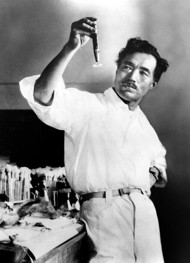Linking Late-Stage Syphilis to Dementia

Noguchi, Hideyo
Courtesy of the Rockefeller Archive Center
At the beginning of the twentieth century syphilis was a pressing public health problem. Scientists first identified the spiral-shaped bacterium that causes the disease—Treponema pallidum—in 1905. A few years later the German researcher Paul Ehrlich created the first drug that could kill the spirochete, the arsenical Salvarsan, ushering in the modern era of drug development. Yet many fundamental questions remained. Doctors had long suspected that certain diseases of the central nervous system were, in fact, late stages of syphilis infection—a kind of dementia and paralysis known as general paresis, and spinal tabes, the degeneration of nerve cells in the spine. In 1912, at Rockefeller, Hideyo Noguchi (1876-1928) examined the brains and spinal cords of dozens of people who had died from these conditions. He was the first to find the syphilis spirochete in the tissues, and prove the link between nervous system diseases and the bacterium.
In the era of microbe hunters, Noguchi had a brilliant career, claiming to culture for the first time organisms such as syphilis and other spirochetes, the polio and rabies viruses, and the infectious agent of Oroya fever. During a 1927 trip to West Africa to search for the organism that causes yellow fever, Noguchi contracted this disease and died. Some of Noguchi's research proved durable; other results were later found to be incorrect. At the time, however, scientific leaders around the world applauded Noguchi's achievements. He remains a national hero in Japan, and his portrait appears on the 1000-yen banknote.
Hideyo Noguchi graduated from Tokyo Medical College in 1897. After an assistantship at the General Hospital in Tokyo, he took a post at the Government Institute of Infectious Diseases, which had been founded by Kitasato, a student of Robert Koch. Noguchi met Simon Flexner in 1899, when Flexner visited the Kitasato Institute. He joined Flexner at the University of Pennsylvania in 1899, and moved to the Rockefeller Institute in 1904, after Flexner became the Institute's first director. Noguchi spent the remainder of his career at Rockefeller. In his lifetime he gained international fame, and received many awards, including the Kober Prize. The Japanese Order of the Rising Sun was conferred posthumously.
Selected Publications
Hideyo Noguchi H and Moore JW. A demonstration of Treponema pallidum in the brain in cases of general paralysis. J Exp Med, 1913, 17:232-238
http://www.jem.org/cgi/reprint/17/2/232
Noguchi H. Morphological and pathogenic variations in Treponoma pallidum. J Exp Med, 1912, 15:201-204
http://www.jem.org/cgi/reprint/15/2/201
Further Reading
Flexner S. Hideyo Noguchi: A biographical sketch. Science, 1929, 69: 653-660
Corner GW. A History of the Rockefeller Institute, 1901-1953. New York: Rockefeller Institute Press, 1964
Kita A. Dr. Noguchi's Journey: A Life of Medical Search and Discovery, Kodansha International, 2005
Takahashi A. Hideyo Noguchi, the pursuit of immunity and the persistence of fame: a reappraisal. In Stapleton DH, Creating a Tradition of Biomedical Research: Contributions to the History of The Rockefeller University. New York: The Rockefeller Univ Press, 2004
